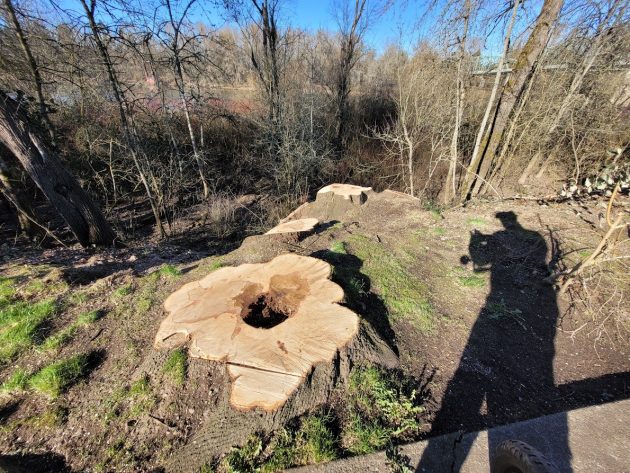
Stumps along the Albany riverfront show internal rot. The Ellsworth Street Bridge is visible through the jungle of riparian tree cover that remains.
If you go down to the Albany riverfront during this week’s controversial removal of about 80 trees, you’ll be able to see for yourself at least two things.
One is that some of the trees coming down actually had problems and were doomed just as the city said, based on an evaluation by arborists.
Some of the stumps show a hole in the middle where the trunk had decayed. Sooner or later these tall trees would have had to come down.
The other thing you see is that criticism of the tree removal, especially in letters to the local paper, ignores the facts and misses the point.
The riverfront project is removing some tall trees, but plenty of trees remain, including tall ones.
Somebody writing from Corvallis asked: “Albany, do you really want a riverfront of cement and steel?”
Where does that come from? The only cement or concrete in the renovation plan is in the Dave Clark Path. The path has been there for 30 years. It is crumbling in places and needs to be repaired.
And if there’s any steel, it’s in the short sections of rail that keep unwary walkers from tumbling down the river’s steep bank.
Nobody appreciates trees more than I. But I wish people complaining about this particular park and riverside restoration program would take a look at the scene before they hold forth. (hh)

And here’s a closer look at that stump.


Hasso: What will the splash pad be made of? Concrete, I assume.
The healthy trees should have been left alone, the park needs shade and it looks so much nicer, like an actual park. I understand some needed to be removed for that splash thing, but I still feel they took too many. Its definitely not going to be the same but thats fine for some and the rest of us will find other places when we need to.
If it weren’t for your blog post we probably wouldn’t have even been told about the trees the city ruthlessly destroyed. Council and city staff run amok for their vanity project! Thank you Hasso for alerting us to this travesty. I’m sure there’s one or two trees like your photo but the rest are all healthy. Like the other nice lady from Corvallis said, I bet the arborist has a financial stake in this whole boondoggle.
Plant a young tree in the center hole of the stump. It will protect and feed the new one and provide a new begining.
The tree removal as well as the whole design package was presented to the City of Albany and accepted after public input. You could have been there to provide input. I admire the work that certified arborists perform. They are educated as to tree growing, diseases, and tree hazard.
Hasso, this is very well stated and your photos prove it!
Thanks for being out there for us.
While they are at …plans to remove the riparian jungle? Better view of the mighty river?
Yes: http://albanywaterfront.net/
Like the felled trees before it, Mr. Hering casts a large shadow.
Old trees will fall down and cause grief. Good they are removed and new ones are planted.
I walked the area yesterday to see for myself. As stated in the story I could clearly see in almost all the cut trees definite signs of rot. Was also pleased to see that the big trees surrounding the gazebo were NOT marked for cutting and will still shade that section of the park.
As the center of the trees decay cavities for birds, bats, and other critters become available … leaving “snags” foster a woodland diversity that mimics a natural forest. Albany citizens are blessed with a riparian corridor (Willamette Greenway)
It is highly amazing to me that people try to justify manmade progress by questioning a natural system that has been in place since the beginning of time. Our ecosystem is meant to sustain the life of everything on earth, including humans. Water all over the world is becoming increasingly polluted and contaminated. Albany’s water supply is directly affected by the river and its’ wellbeing. This should take precedence over who can view the river or enjoy the park. These conversations center on the city of Albany’s government egos and right of power. It is just pure vanity to push economic growth over the health of the community.
Albany’s drinking water comes from the Santiam River.
It is not directly used for drinking water but it affects the ground water.